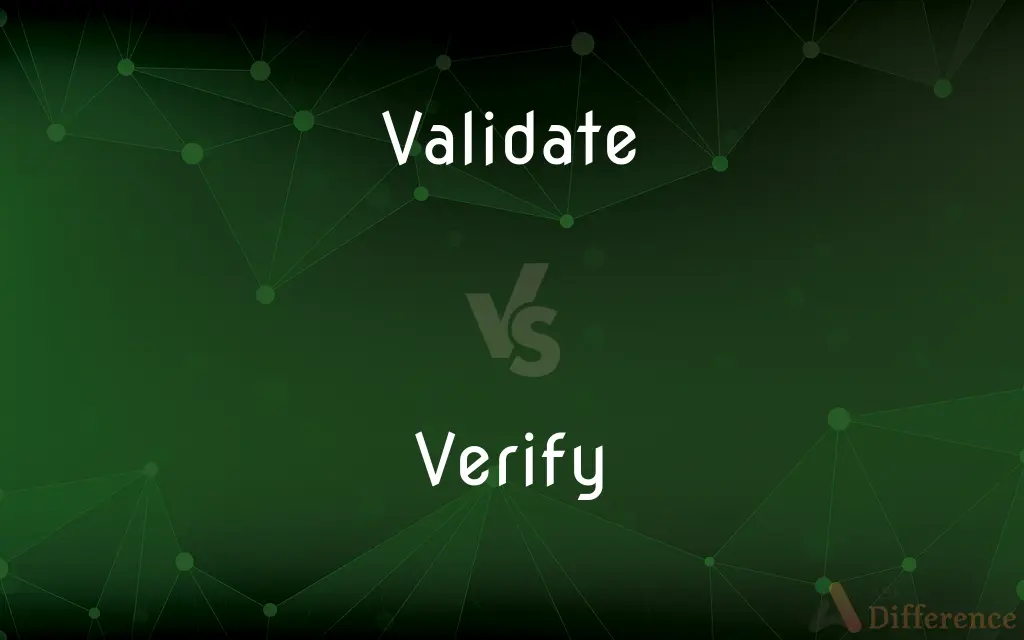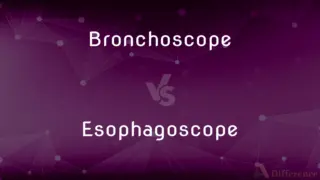Validate vs. Verify — What's the Difference?
By Maham Liaqat & Fiza Rafique — Updated on March 7, 2024
Validation ensures a product or system meets the needs and expectations of its users, focusing on suitability, while verification confirms that it meets specified requirements, emphasizing correctness.

Difference Between Validate and Verify
Table of Contents
ADVERTISEMENT
Key Differences
Validation is a process aimed at ensuring a product, service, or system meets the needs and expectations of its intended users. It answers the question, "Are we building the right product?" This involves assessing and confirming the suitability of the final product for its intended use. On the other hand, verification is concerned with whether the product is built correctly according to the predefined specifications and requirements. It addresses the question, "Are we building the product right?"
While validation involves subjective assessment and often requires feedback from the end users to evaluate the product's effectiveness and user satisfaction, verification is more objective, focusing on systematic checks and tests to ensure that each development phase meets the specified requirements. Validation looks at the product's end use and user experience, whereas verification examines the technical and functional compliance with the requirements.
In the development process, validation usually takes place after verification, as it seeks to ensure that the entire product or system delivers the desired outcome in the real-world scenario. Verification activities, however, are carried out throughout the development phases, from initial design to final testing, ensuring that each stage meets the specified criteria set forth for the product.
Validation methods often include user acceptance testing, beta testing, and real-world application trials, requiring user interaction and feedback. Verification methods, by contrast, include inspections, reviews, and non-functional testing, such as performance and security testing, which do not necessarily involve end users but rather focus on meeting predefined specifications.
Despite their differences, both validation and verification are crucial for the success of a product or system. They work hand in hand to ensure that a product not only meets the technical specifications but also fulfills the user's needs and expectations, ultimately leading to a higher quality and more user-centered product.
ADVERTISEMENT
Comparison Chart
Focus
Suitability for intended use.
Correctness to specifications.
Question Addressed
Are we building the right product?
Are we building the product right?
Method
Subjective assessment, user feedback
Objective checks, tests
Timing
After verification, before release.
Throughout development phases.
Examples
User acceptance testing, beta testing
Inspections, performance testing
Involvement
End users
Developers, testers
Outcome
Meets user needs and expectations.
Meets predefined requirements.
Compare with Definitions
Validate
Assessing the suitability of a product for its intended purpose.
User feedback helps to validate the design's effectiveness.
Verify
To confirm a product meets specified requirements.
Developers verify the code against the functional specifications.
Validate
To ensure a product meets user needs and expectations.
They validate the software by conducting user acceptance testing.
Verify
Essential throughout the development lifecycle.
Verification activities include code reviews and automated testing.
Validate
Focused on the end-use and satisfaction.
Validation confirmed the app's relevance for its target audience.
Verify
Involves objective testing and review.
The team conducts regular verifications to ensure ongoing compliance.
Validate
Involves subjective evaluation and user involvement.
Beta testing is a key method to validate a product's market fit.
Verify
Ensures technical and functional specifications are met.
Verification processes help in maintaining quality control.
Validate
Ensures the product fulfills its intended purpose.
Validation processes aim to ensure the product solves the right problem.
Verify
Checks for correctness and adherence to standards.
Verification tests confirmed the software's performance metrics.
Validate
To establish the soundness, accuracy, or legitimacy of
Validate the test results.
Validate a concern.
Verify
To attest to the truth of (something) formally or under oath.
Validate
To declare or make legally valid
Validate an election.
Verify
To make a formal verification in support of (a pleading).
Validate
To mark with an indication of official sanction
The official validated my passport with a stamp.
Verify
To demonstrate the truth or accuracy of, as by the presentation of evidence
Experiments that verified the hypothesis.
Validate
(transitive) To render valid.
Verify
(transitive) To substantiate or prove the truth of something.
Validate
(transitive) To check or prove the validity of; verify.
Verify
(transitive) To confirm or test the truth or accuracy of something.
Validate
(ergative) To have its validity successfully proven.
The data file cannot be imported because it doesn't validate.
Verify
To affirm something formally, under oath.
Validate
To confirm; to render valid; to give legal force to.
The chamber of deputies . . . refusing to validate at once the election of an official candidate.
Verify
To prove to be true or correct; to establish the truth of; to confirm; to substantiate.
This is verified by a number of examples.
So shalt thou best fulfill, best verify.The prophets old, who sung thy endless reign.
Validate
Declare or make legally valid
Verify
To confirm or establish the authenticity of by examination or competent evidence; to authenticate; as, to verify a written statement; to verify an account, a pleading, or the like.
To verify our title with their lives.
Validate
Prove valid; show or confirm the validity of something
Verify
To maintain; to affirm; to support.
Validate
Give evidence for
Verify
Confirm the truth of;
Please verify that the doors are closed
Verify a claim
Validate
Make valid or confirm the validity of;
Validate a ticket
Verify
Verify or regulate by conducting a parallel experiment or comparing with another standard, of scientific experiments;
Are you controlling for the temperature?
Verify
Attach or append a legal verification to (a pleading or petition)
Verify
To declare or affirm solemnly and formally as true;
Before God I swear I am innocent
Common Curiosities
How do validation and verification differ?
Validation focuses on suitability for the intended use and user satisfaction, while verification confirms adherence to technical and functional specifications.
Can a product be verified but not validated?
Yes, a product can meet all technical specifications (verified) but still fail to meet user needs or expectations (not validated).
What role do end users play in validation?
End users are crucial in validation for providing feedback on whether the product meets their needs and is suitable for its intended purpose.
How do verification and validation contribute to product quality?
They ensure that a product is both technically sound and effectively meets user needs, thereby enhancing overall product quality and user satisfaction.
What does it mean to validate a product?
Validating a product means ensuring it fulfills the intended user needs and expectations, often involving user feedback and real-world testing.
When is verification performed?
Verification is performed throughout the development process, from initial design to final testing, to ensure compliance with specifications at every stage.
What is the purpose of verification?
The purpose of verification is to confirm that the product meets all specified requirements and design documents, through objective testing and review.
Why are both validation and verification important?
Both are essential to ensure a product is not only built correctly according to specifications but also meets the end users' needs and expectations, leading to higher quality and satisfaction.
What methods are used in validation?
Validation methods often include user acceptance testing, beta testing, and real-world application trials.
Is validation always the final step in the development process?
While validation often comes after verification, ongoing user feedback may lead to further adjustments, making it a continuous process in some cases.
Share Your Discovery

Previous Comparison
Bluestone vs. Limestone
Next Comparison
Bronchoscope vs. EsophagoscopeAuthor Spotlight
Written by
Maham LiaqatCo-written by
Fiza RafiqueFiza Rafique is a skilled content writer at AskDifference.com, where she meticulously refines and enhances written pieces. Drawing from her vast editorial expertise, Fiza ensures clarity, accuracy, and precision in every article. Passionate about language, she continually seeks to elevate the quality of content for readers worldwide.














































